
Proof is piling up that Britney Spears is a victim of mind control at the hands of unscrupulous handlers. While mass media points their finger at specific “controlling” individuals, it is increasingly obvious that she is the product of a system that totally suppressed her free will and personal freedom. What makes Britney’s case different from others is that the apparent feud between her past and present handlers is causing some otherwise “censored” information to leak out about how pop stars are completely owned and handled by people behind the scenes. If people are lead to believe that Spear’s case is special, well, it is more common than most would believe.
The upcoming Sam Lutfi trial (Spear’s former manager and handler) might bring up more revelations about Britney’s near-slave status. The singer’s former nanny is set to testify about Lutfi’s manipulative tactics and, according to a source: “she just wants the truth to come out and it will be shocking”. Britney herself won’t be at the trial because, according to the judge, it would cause her ‘irreparable harm and immediate danger.’ Re-read this sentence closely and ask yourself : “Why?” Is it because MK slaves who learn about their true condition are often programmed to “self-destruct”?
As the article below states, all of her internet activities are closely controlled and monitored so, chances are, she’ll never end up on Vigilant Citizen. Hope she’ll find a way to free herself one day.
Britney Spears’ former nanny ‘to testify in Sam Lutfi trial that star has been emotionally manipulated’ by her handlers
Britney Spears finally has her personal and professional back on track, bagging a high-profile position as a judge on The X-Factor and marriage proposal from agent Jason Trawick.
But trouble is looming for the the vulnerable pop star as her public meltdown is set to be dredged up in a Los Angeles courtroom again this week.
Former manager Sam Lutfi is suing the singer and her parents for breach of contract, defamation and libel and RadarOnline has reported that Lourdes Torres, a former nanny for Britney’s children, will testify that the singer has been emotionally manipulated throughout her court-mandated conservatorship.
Torres, who cared for Britney’s two sons in the months after the conservatorship was instated in 2008, will testify to witnessing emotional manipulation.
She also claims that she quit her job because she was ‘so disturbed’ by what she saw happening to the singer, a source said, adding: ‘[Torres] isn’t after money, she just wants the truth to come out and it will be shocking.’
The trial is expected to last close to three weeks, with Lutfi, Britney’s fiance, Jason Trawick and her parents scheduled to testify.
Lutfi also filed papers at Los Angeles County Superior Court in September asking a judge to make the former Disney star available as a witness.
But Britney will not be taking the stand as, according to Fox News, the judge has ruled it could potentially cause her ‘irreparable harm and immediate danger.’
Spears’ legal team have successfully prevented the singer from having any contact with Lutfi for the past three years by having a restraining order granted against him.
Spears’ father applied for the order in 2009 claiming: ‘Mr Lutfi has drugged Britney. He has cut Britney’s home phone line and removed her cell phone chargers. He yells at her. He claims to control everything – Britney’s business manager, her attorneys and the security guards at the gate.’
And since the restraining orders have expired, Britney’s team have restricted her cellphone and Internet usage to ensure that Lutfi is not able to contact her.
A source told RadarOnline.com: ‘Britney’s cell phone and internet use is restricted and heavily monitored, and this is done for her protection.
‘Britney’s father Jamie and her fiance Jason want to make sure that her former manager, Sam Lutfi, isn’t able to contact her’.
‘Britney and Jason essentially share a cell phone, and it’s routinely checked to see who has been calling.’
The 30-year-old, who was committed to a psychiatric ward in 2008, is also not allowed access any gossip websites to prevent her from seeing any negative stories about herself.
But despite the fact that a judge has ruled that Britney isn’t mentally competent enough to testify, a source told RadarOnline that Lutfi’s lawyers are still pushing the issue.
While it is unlikely the singer will ever testify, if she did the source says: It would be explosive for so many reasons.’
Jury selection began last Friday and will continue on Tuesday, with opening statements expected later in the week.
Source: Mail Online
From Mind Control to Superstardom: The Meaning of Lady Gaga’s “Marry the Night”
The music video “Marry the Night” tells the story of Lady Gaga’s rise to fame in the entertainment industry. Oddly enough, her “journey” begins with her describing the symptoms of a trauma-based mind control victim. Is there a deeper meaning to this video? We’ll look at the symbolism of “Marry the Night” and its underlying occult meaning.
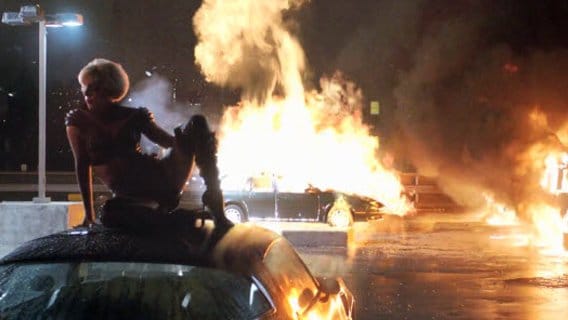
Lady Gaga generated a great buzz among her fans when she announced that the video to Marry the Night would reveal a part of her past. Did her fans expect the video to begin with a traumatized Gaga inside a psychiatric ward with a bunch of lobotomized girls? Probably not. But from that strange starting point, the video proceeds to depict Gaga’s rise to super-stardom. How does all of that tie in together? To most, this doesn’t really make any sense. However, to those who understand the relation between trauma-based mind control and the entertainment industry, it makes perfect sense. While many of her previous videos referred to mind control in subtle and symbolic ways (see previous articles on Vigilant Citizen), Marry the Night takes it a step further, pretty much spelling it out. At the very start of the video, Gaga’s monologue defines in unequivocal terms the plight of a mind control victim. Despite her hardships, she says, she is determined to make it in the music business and is ready to do whatever it takes to reach her goal. She therefore “marries the night”, an expression that has a profound meaning.
The video is Lady Gaga’s directorial debut and, according MTV.com it is basically a “big thank you” to Interscope Records – the record label that signed her. This is definitely true but the video also says thanks to those behind her record label: the “Night” that she married. Let’s look at the video’s most important scenes.
In the Psychiatric Ward
The intro of the video shows Gaga as the patient of some kind of psychiatric ward. While laying on a stretcher that is pushed by two nurses, Gaga describes the way she perceives reality. Affected by a violent trauma, Gaga escapes into her own world to be able to go on. The mental dissociation that is described by Gaga is in direct accordance with the purpose of trauma-based mind control, the basis of Monarch Programming (see the article Origins and Techniques of Monarch Mind Control for more information). Monarch programming uses various methods, including violence, drugs and abuse to induce violent trauma and cause the victim to dissociate – a natural defense mechanism of the brain. The fracture of the personality that results from the process is then exploited by the mind-control handlers to program within the subject’s mind new “alter” personalities. This is also described in Marry the Night, as Gaga creates a new persona to obtain superstardom.The process also causes the victims to have huge memory gaps when recollecting the past. In during the intro of the video, Gaga describes how a victim of Monarch programming would perceive reality:
“When I look back on my life, it’s not that I don’t want to see things exactly as they happen, it’s just that I prefer to remember them in an artistic way. And truthfully, the lie of it all is much more honest, because I invented it. Clinical psychology arguably tells us that trauma is the ultimate killer. Memories are not recycled like atoms and particles in quantum physics. They can be lost forever. It sort of like my past is an unfinished painting and, as the artist of that painting, I must fill in all the ugly holes and make it beautiful again. Its not that I’ve been dishonest, it’s just that I loathe reality.”Gaga basically says that she went through trauma that was so horrific that it caused her to dissociate from reality. Since she cannot cope with the true nature of her existence, her psyche has “filled in all the ugly holes” and created an inner-world where she can escape and survive mentally. This is exactly what happens with MK slaves, who, while dissociated into their fantasy world, get programmed by their handlers. Gaga then proceeds to describe how her dissociated mind perceives her surroundings.

The nurses wear their caps in a "stylish" way because we are seeing Gaga's dissociated perception of reality
Lobotomies also appear to be happening in Gaga’s ward. As she arrives in her room, we notice that it is filled with brain-dead girls with bandages around their heads. This hints that Gaga’s “institution” deals with mind control-related stuff.
On her bed, Gaga speaks with a nurse – who also happened to have delivered her when she was born. This is rather odd (for many reasons) but confirms that Gaga’s existence has been under tight control since her youth. Is this bit part “autobiographical” or fiction? Hard to say.

Something happened to her back
The Metamorphosis
After the depressing hospital scene, Gaga is in her apartment when she gets a phone call from her manager announcing that she’s been dropped by her label. She replies “But I’m an artist!”, as if artistic integrity is the top priority of record labels. She then loses it and goes into a topless frenzy involving Cheerios and smudged makeup. The messy scene is juxtaposed with images of Gaga gracefully dancing ballet – as a “true artist”. The two scenes are diametrically opposed yet have noticeable similarities. The ballet scene ends with Gaga topless and crying, indicating that both scenes happen at the same time: One in real life and one in her head.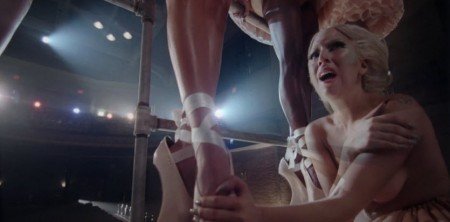
Gaga
topless and crying, like in the apartment scene. This represents how
Gaga perceives herself, yet she is rejected by her label.

The
transformation from Stefani Germanotta to the alter Lady Gaga
symbolized by the dying of her hair blonde. She is beginning to do what
is needed to make it in the entertainment industry - A shallow alter-ego
that will do what is required by record labels. While she's doing this,
she's humming "Marry the Night", something she is actually beginning to
accomplish here.
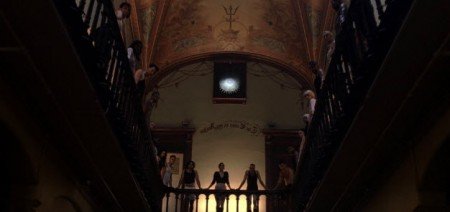
As
the camera pans, we see several interesting things. At the top of this
shot is Poseidon, the king of Atlantis with his trademark pitchfork.
Although he was probably painted there because the shooting location is a
harbor (a nautical place), the god takes another meaning in the context
of the video: Poseidon is an important figure in the occult elite's
mythology as he is the king of Atlantis, the place where the Mysteries
have originated from. Under Poseidon is a lighted star similar to the
Blazing star found in Masonic lodges. Underneath the star is written
"The Cross is My Anchor" - a Christian saying - but in reverse. I am
pretty that the phrase is not actually written in reverse in Snug
Harbor. Why was the image flipped? Does this represent Gaga's spiritual
shift as she "Marries the Night"?
Marrying the Night
Most music sites say that Marry the Night is about going out, partying and having fun in New York city. But, as it is often the case with Gaga’s works, the symbolism and the imagery of the video hints at a deeper, more ritualistic meaning. As we have seen above, Gaga is passionately fueled by her drive for success and she appears to realize that the key to make it in the industry is: Initiation. Or, in more sinister terms, selling one’s soul.In the context of the video, the expression “marry the night“ takes an almost metaphysical connotation. Marriage is a religious ritual, a binding association between two people. What does it mean when one marries the night? It can mean associating with people who deal in the dark: the occult elite (those we call the Illuminati). It can also signify embracing one’s own flaws and “dark side”. In all cases, there is a definite sense of “rebirth” in the process. And, that’s what we see: A blond Lady Gaga (the alter of Stefani Germanotta) emerges from a Trans-Am dressed in black.
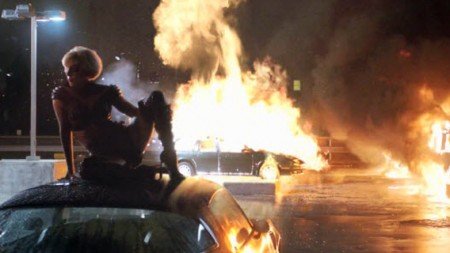
Gaga then goes to “Pop Star Training”. No more ballet, it’s all about doing cool, hip, music video choreography now.

"Yeah, that's how you need to dance if you want to be on MTV. Go back there and keep doing it".

With her cool shades and fashionable backup dancers, Gaga now has what it takes to be a product of the music industry.

When
you "Marry the Night" (or sell your soul), the doors of the music
business magically open. Gaga gets an appointment with Interscope
Records.

In
this fiery scene Gaga is dressed in red - the color symbolic of
sacrifice and initiation. She is wearing a Paco Rabane hat that is
fashionable and symbolic: it completely hides her head. It is owned by
the Night now.

The
setting of Gaga's performance on X Factor emphasizes on the underlying
occult meaning of the song. The full moon, the torches and the religious
imagery play on the spiritual significance of "marrying the night".
Gaga began the song with her head literally chopped off, a perfect way
to describe what figuratively happens to industry pawns.
In Conclusion
Although many describe Marry the Night as a “new direction” for Lady Gaga, the video still exploits her favorite theme: The price of fame. The intro of the video is basically a introductory course in trauma-based mind control, where she describes how dissociating allows her to cope with reality. As the artistic brunette turns into a blonde diva, the Lady Gaga alter-ego is created, one that will do what is required to make it in the music business. The most important requirement is “marrying the night”, which is a poetic way of saying “selling one’s soul” and associating with the dark side. Gaga had to deny everything she previously was to become a brand new person. Therefore, beneath the fashion and the dancing, the video hides an underlying ritualistic theme, as the death of a ballet dancer gives birth to an MTV pop star. From the broken girl who had nothing to lose to international superstar, it took a marriage with the dark side to turn things around. But at what cost? The final scene of the video, complete with hellish fire and a sacrificial red dress tells volumes.In the grand scheme of things, despite her apparent originality, Gaga brings to the youth a message that is very similar to other pop stars: “Mind control is cool, everyone is doing it” and “Submit to the dark side and you’ll get what you want”. But when things get scary and the night becomes an abusive husband, asking for divorce won’t be an option. Ask Princess Diana.
Katy Perry’s “Wide Awake” : A Video About Monarch Mind Control
Katy Perry’s music video “Wide Awake” is another offering from the pop music industry that conceals references to Monarch programming within its symbolism. References to this practice occur often in mass media but are often coded using specific symbols and imagery. We’ll look at the hidden meaning of Katy Perry’s “Wide Awake”.
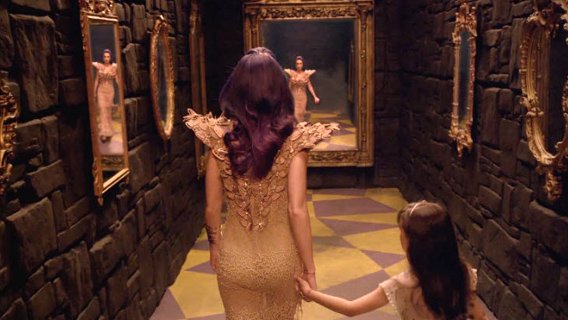
Many articles on this site described how many items of popular culture conceal within their symbolism references to an unknown, horrendous practice: Monarch programming. This technique of mind control seeks to create fully “programmable” individuals and is used by the shadowy elite in fields such as the military, politics and the murky underworld (for detailed information on Monarch programming, read the article Origins and Techniques of Monarch Mind Control). Another area in which mind control (especially Monarch programming) is used is the entertainment business – not only because some celebrities are actual victims of mind control, but because entertainment is used to subtly normalize and glamorize this awful practice through symbolism.
Katy Perry’s video Wide Awake is yet another music video that alludes to the concept of Monarch programming through its storyline and its imagery. While this might not be obvious to most people, those who have some knowledge of the subject of mind control find it extremely blatant.
In many ways, the video resembles works that have been previously analyzed on this site, such as the movies Labyrinth and Sucker Punch and music videos like Paramore’s Brick by Boring Brick. All of these productions visually represent the inner-world of Monarch slaves through a specific set of symbols: mirrors, butterflies (especially Monarch butterflies), mazes and so forth. Not only do these objects aptly portray psychological concepts, they are actual “trigger images” used in mind control on Monarch slaves. Wide Awake fully utilizes this set of symbols, which gives the storyline a deeper, and more disturbing, meaning.
Most mainstream media articles on Wide Awake say that it is about Katy Perry “navigating the maze of fame”. While this might be true, the video cannot be completely explained without considering the element of Monarch programming. For instance, why is Perry shown at sitting on a wheelchair, completely “out of it” inside a health institution? Probably because there is more to the video than meets the eye. Let’s look at the deeper meaning of its scenes.
Wide Awake
At the beginning of the video, we see Katy completing the filming of her popular video California Gurls. She is wearing her now famous pink wig. She is fully into her “sexy pop star” persona.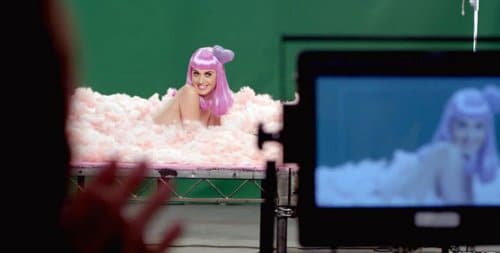
Katy is doing what is expected of her in front of the cameras.
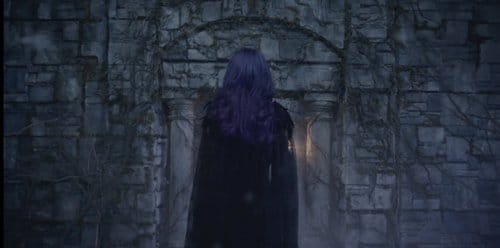
Katy
stands at a gateway flanked by two pillars. In esoteric symbolism,
pillars guard the entrance of sacred and mystical places. In this case,
it is Katy’s own mind.

During
mind control, handlers literally take control of the slave’s mind and
can program everything within it. This causes the slave to become a
stranger inside his/her own mind as their thoughts are meticulously
controlled and programmed.

Katy’s
core persona is the “real her” (Katheryn Elizabeth Hudson), complete
with her values and convictions. It is the personality she had before
being subjected to programming. Mind control seeks to strip individuals
from their core persona in order to program a new one that will easily
comply with orders. Here, Katy has the opportunity of reconnecting with
her core persona. It will indeed become her guide.
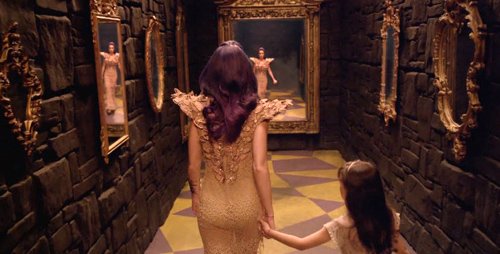
Katy
and little Katheryn find themselves in a room full of mirrors. The
dark-and-light floor represents duality, a concept extremely important
in mind control programming. The fact that little Katheryn’s reflection
does not appear in the mirror emphasizes the fact that the girl is not
real, but a part of Katy’s psychology. Katy’s dress is full of
butterflies, a rather strong reminder that she is under Monarch
Programming.
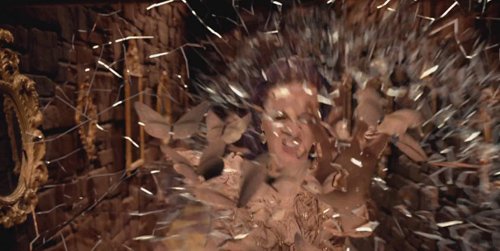
As
Katy breaks the mirror, we see butterflies flying off her dress – an
image that emphasizes the fact that she is breaking out of Monarch
programming.
Breaking Out?
Then next scene is in sharp contrast to the rest of the video. While before it was all about fantasy and mystery, we are now in a cold, sterile health institution. In other words, we appear to be out of Katy’s head and back to reality. Katy appears to be completely “shut down”, sitting on a wheel chair in what appears to be a mental institution. Is this her MK programming site?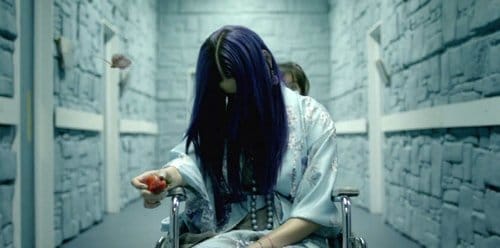
Katy
looks like what MK victims must look like after enduring the trauma of
Mind control . She is totally “out of it” and probably drugged by the
strawberry she is holding.
While Katy is somewhat of a zombie, her core persona, little Katheryn, is “Wide Awake” and is determined to get out of there. Some people, however, do not want to see that happen.
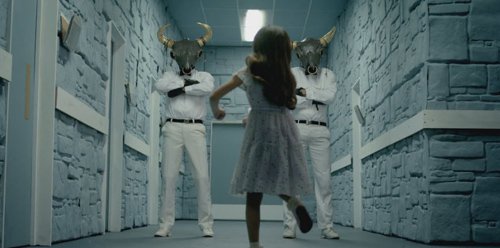
Two
men with horned heads (see Baphomet) block Katheryn’s way to freedom.
Do these non-human, evil-looking men represent Katy’s handlers?
The lyrics of the song convey this sense of liberation from a deceitful and oppressive state of mind. Here’s the first chorus:
I’m wide awakeSo, at this point, one might ask: Is this video about Katy actually breaking out of mind control? The rest of the video might answer the question.
Yeah, I was in the dark
I was falling hard
With an open heart
I’m wide awake
How did I read the stars so wrong?
I’m wide awake
And now it’s clear to me
That everything you see
Ain’t always what it seems
I’m wide awake
Yeah, I was dreaming for so long
Upon leaving the institution, Katy and her core persona find themselves back in the fantasy land.

Katy
and her core persona are back in the dissociative fantasy land - at
the other side of the Labyrinth where things seem nicer.
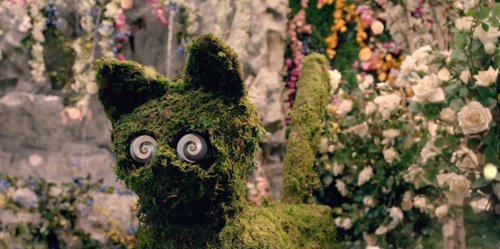
This
cat with hypnotic eyes is a reminder that Katy might still be tightly
monitored and under the control of her handlers. The butterflies on
Katy’s head are also a good indicator of this fact.

Katheryn,
the core, authentic persona of Katy says goodbye. Why is she leaving?
Isn’t our core personality something we should ALWAYS have?

Back
in her dressing room, realizes that she’s been given a butterfly. Did
her Katheryn give Katy the poisonous gift of being back under mind
control?
Did she learn from something from Katheryn and is now better equipped to face the pitfalls of celebrity? Maybe. However, the orgy of butterflies in the video reminds us that, in the end, she is still under the control of the music industry and the MK symbolism it promotes. Need more proof? Check out her attire while she performed Wide Awake at the MuchMusic Video Awards in Canada.
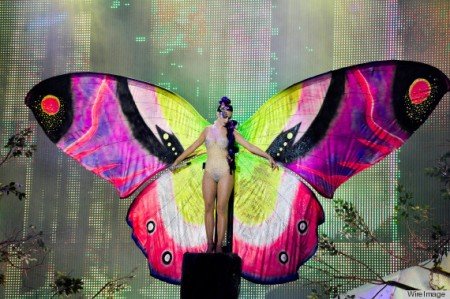
Katy is basically one big giant butterfly – the ultimate symbol of Monarch Programming.

Monarch butterflies over one eye. That’s like VC 101.
In Conclusion
Katy Perry’s Wide Awake is a prime example of Monarch programming symbolism being promoted in mass media products. While it may be deemed “original” and “imaginative” by many, it is strikingly similar to other MK-themed video analyzed on this site. For instance, Paramore’s Brick by Boring Brick also features a younger (purer) version of the singer, a flurry of butterflies, rooms full of mirrors and so forth. Why are all of these symbols found in these unrelated videos (any countless others)? It is because these symbols are, in fact, related: They are symbols of Monarch Programming mind control. This is the common thread uniting these symbols. It also explains the otherwise puzzling plots of the videos.Although it is probably the most disgusting and vicious concept known to man, Monarch programming is often referenced in popular culture. And, since Monarch programming is one of the ways the occult elite keeps a stranglehold on many areas, including the entertainment industry, it is often subtly glamorized in mass media. Most people let all of this imagery go straight to their minds without even understanding its true meaning. However, there is one way to not allow these unwanted messages to reach our brains: Be TRULY wide awake.
The Police State Agenda in Jay-Z and Kanye’s “No Church in the Wild” and Adam Lambert’s “Never Close Our Eyes”
Why do music videos these days often feature police in riot gear and violent repression? Is there an attempt to normalize the concept of a police state in mass media? Two recent and blatant example of this agenda is Jay-Z and Kanye’s video “No Church in the Wild” and Adam Lambert’s “Never Close Our Eyes”. Even though these songs are different in style, their underlying message is similar and is on par with the police state agenda of the world elite. This article will look at the meaning and implications of these videos.

What does Jay-Z have in common with Adam Lambert? At first glance, nothing at all. At second glance, they’re mainstream artists part of the music industry and at some point, even though they differ in style and substance, they are expected to push the agenda of the elite. As we discussed in the article The Transhumanist and Police State Agenda in Pop Music, the entertainment industry is used to promote and normalize the concept of a police state in the eyes of young people. Since the publishing of that article in early 2010, many other artists have featured an oppressive police force and violent repression as part of their works. From performances in live shows to music videos, there is a conscious and constant effort to associate the cool and sexy aura of pop stars with the otherwise abhorrent sight of riot police in a free society.
Two recent examples of the perpetuation of the police state agenda in popular culture are Jay-Z and Kanye West’s music video No Church in the Wild and Adam Lambert’s Never Close our Eyes. In spite of, or perhaps because of, the fact that these songs are two different genres that aim to reach two different markets, they both contribute to the saturation of popular culture with police state imagery. While the authorities are not necessarily portrayed as the “good guys”, they are nevertheless there, as if their presence at any kind of public demonstration is normal. Let’s look at the symbolism and the underlying meaning of these two videos.
No Church in the Wild
No Church in the Wild has rather profound philosophical implications. The lyrics are of course up for interpretation, one of which is that the song is a rejection of religious dogma to embrace a more humanist (and maybe hedonistic) way of life. The title of the song itself is a figurative way of saying that religious institutions such as the Church are unnecessary human constructs that are not found in nature. That being said, the video consists of lovely footage of trees and streams … oh no, actually the video is about a bunch of dudes getting beat up by riot police. Why? What’s the relationship to the lyrics? I am not totally sure, but the video is pretty much five straight minutes of angry rioters and violent police repression. A great way to desensitize young people to the concept of police state.The video begins with a guy lighting up a Molotov cocktail in Prague (although some shots appear to be taken in Paris, France).
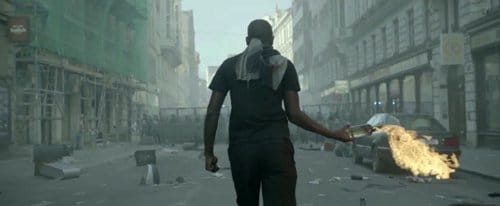
In the video, the rioters do not appear to have a valid cause and they are clearly portrayed as the aggressors.
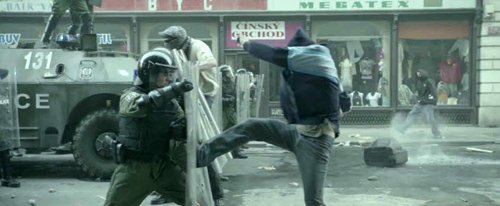
The
rioters are angry and aggressive. Without a back story describing the
source of their grief, it is rather hard to identify with them.
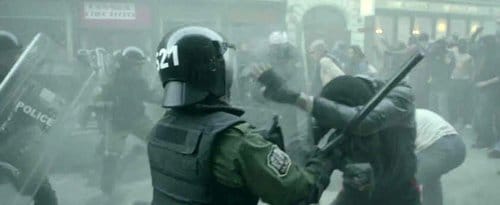
This guy gets clubbed back to sanity.
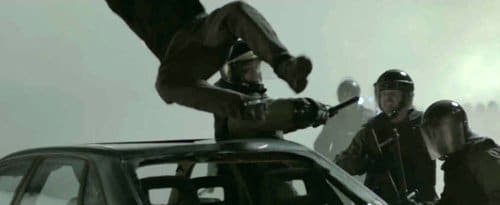
This one gets his feet swiped off to fall on his back while other policemen apparently laugh at him.
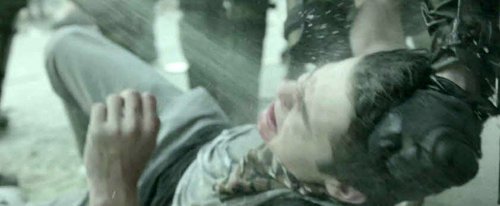
This
one gets a face full of tear gas at point blank range, a lot like
student protestors at UC Davis. I am pretty sure that this is NOT the
way the user manual recommends using tear gas.
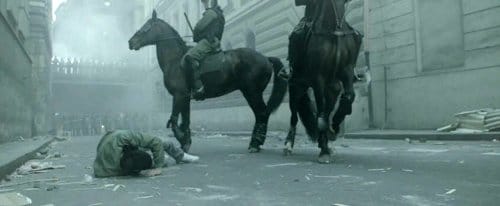
This guy got chased down by police cavaliers and got smacked right on the head with a nightstick.
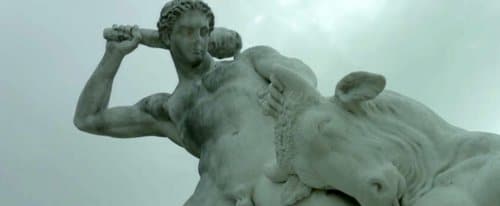
Right
after we see a rioter get clubbed down by a policeman, we see a shot of
a statue of Theseus clubbing the Minotaur. This story from Greek
mythology esoterically represents the slaying of man’s “lower animal”
side in order to achieve illumination. Is the video saying that the
rioting masses are the “lower animal” side of society that needs to be
tamed (or slayed) by the illuminated?
Later in the video, day turns into night … and strobe lights, the kind we usually see in clubs and raves, appear in the riot scene.
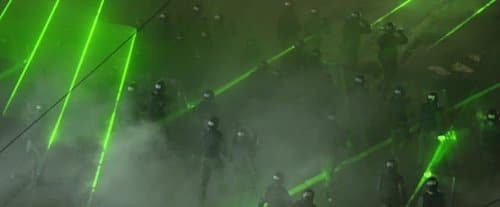
Police in riot gear surrounded by strobe lights. They are really trying to associate police with stuff young people enjoy.
At the end of the video, nobody truly wins or loses. Rioters fight back and appear triumphant while police still stand their ground. In other words, nothing has changed and status quo is preserved. An elephant makes an odd appearance in the streets of Paris, reminding the viewers that the “wild” in question is, in fact, our society, where people act like animals and the strongest one wins. In this wilderness, there is no Church, no respite from the savagery, just the stone gaze of statues overlooking the violence. These sculptures represent the puppet masters, those who pull the strings on both sides in order to advance their agenda of a more controlled and repressive society.
The Police State Agenda in Jay-Z and Kanye’s “No Church in the Wild” and Adam Lambert’s “Never Close Our Eyes”
Jun 13th, 2012 | Category: Music Business | 228 comments Why do music videos these days often feature police in riot gear and violent repression? Is there an attempt to normalize the concept of a police state in mass media? Two recent and blatant example of this agenda is Jay-Z and Kanye’s video “No Church in the Wild” and Adam Lambert’s “Never Close Our Eyes”. Even though these songs are different in style, their underlying message is similar and is on par with the police state agenda of the world elite. This article will look at the meaning and implications of these videos.
What does Jay-Z have in common with Adam Lambert? At first glance, nothing at all. At second glance, they’re mainstream artists part of the music industry and at some point, even though they differ in style and substance, they are expected to push the agenda of the elite. As we discussed in the article The Transhumanist and Police State Agenda in Pop Music, the entertainment industry is used to promote and normalize the concept of a police state in the eyes of young people. Since the publishing of that article in early 2010, many other artists have featured an oppressive police force and violent repression as part of their works. From performances in live shows to music videos, there is a conscious and constant effort to associate the cool and sexy aura of pop stars with the otherwise abhorrent sight of riot police in a free society.
Two recent examples of the perpetuation of the police state agenda in popular culture are Jay-Z and Kanye West’s music video No Church in the Wild and Adam Lambert’s Never Close our Eyes. In spite of, or perhaps because of, the fact that these songs are two different genres that aim to reach two different markets, they both contribute to the saturation of popular culture with police state imagery. While the authorities are not necessarily portrayed as the “good guys”, they are nevertheless there, as if their presence at any kind of public demonstration is normal. Let’s look at the symbolism and the underlying meaning of these two videos.
No Church in the Wild
No Church in the Wild has rather profound philosophical implications. The lyrics are of course up for interpretation, one of which is that the song is a rejection of religious dogma to embrace a more humanist (and maybe hedonistic) way of life. The title of the song itself is a figurative way of saying that religious institutions such as the Church are unnecessary human constructs that are not found in nature. That being said, the video consists of lovely footage of trees and streams … oh no, actually the video is about a bunch of dudes getting beat up by riot police. Why? What’s the relationship to the lyrics? I am not totally sure, but the video is pretty much five straight minutes of angry rioters and violent police repression. A great way to desensitize young people to the concept of police state.The video begins with a guy lighting up a Molotov cocktail in Prague (although some shots appear to be taken in Paris, France).

In the video, the rioters do not appear to have a valid cause and they are clearly portrayed as the aggressors.

The
rioters are angry and aggressive. Without a back story describing the
source of their grief, it is rather hard to identify with them.

This guy gets clubbed back to sanity.

This one gets his feet swiped off to fall on his back while other policemen apparently laugh at him.

This
one gets a face full of tear gas at point blank range, a lot like
student protestors at UC Davis. I am pretty sure that this is NOT the
way the user manual recommends using tear gas.

This guy got chased down by police cavaliers and got smacked right on the head with a nightstick.

Right
after we see a rioter get clubbed down by a policeman, we see a shot of
a statue of Theseus clubbing the Minotaur. This story from Greek
mythology esoterically represents the slaying of man’s “lower animal”
side in order to achieve illumination. Is the video saying that the
rioting masses are the “lower animal” side of society that needs to be
tamed (or slayed) by the illuminated?
Later in the video, day turns into night … and strobe lights, the kind we usually see in clubs and raves, appear in the riot scene.

Police in riot gear surrounded by strobe lights. They are really trying to associate police with stuff young people enjoy.
At the end of the video, nobody truly wins or loses. Rioters fight back and appear triumphant while police still stand their ground. In other words, nothing has changed and status quo is preserved. An elephant makes an odd appearance in the streets of Paris, reminding the viewers that the “wild” in question is, in fact, our society, where people act like animals and the strongest one wins. In this wilderness, there is no Church, no respite from the savagery, just the stone gaze of statues overlooking the violence. These sculptures represent the puppet masters, those who pull the strings on both sides in order to advance their agenda of a more controlled and repressive society.
Never Close Our Eyes
While Adam Lambert’s song Never Close Our Eyes differs greatly from No Church in the Wild, it still exposes young people to the same kind of imagery and ends a similar way: An illusion of victory by the revolutionaries – with a special emphasis on the word “illusion”.Never Close Our Eyes takes place in a dystopian future (in mass media, the future is ALWAYS dystopian) in a setting that is reminiscent of George Lucas’ movie THX 1138 or Michael Bay’s The Island, where Adam Lambert finds himself living in a tightly monitored community (or prison), surrounded by emotion-less and zombie-like denizens.

Never
Close Our Eyes is yet another video set in a dystopian future,
characterized by the omnipresence of surveillance cameras. If we are not
already in this vision of the future, we’re definitely heading directly
towards it.
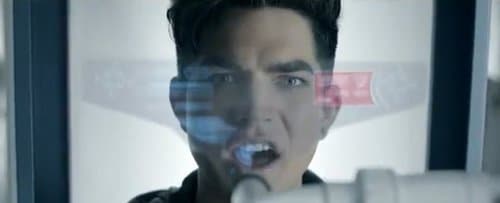
Adam
and his mates must enter soul-sucking machines that remove the color
from people’s eyes – representing the lost of free will and
individuality. Isn’t that what TVs are for?
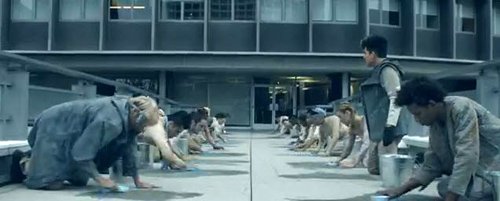
Adam doesn’t feel like doing back-breaking labor anymore. So he gets up in defiance and runs away with a few other rebels.
So up until now, one could say: “Finally, someone who stands up to this NWO crap and delivers an inspiring message”. Most critics effectively describe this video as “Adam Lambert destroying Big Brother with dance”. But does he really destroy Big Brother? Let’s look at the rest of the video and see what really happens.
A bunch of officers meet the rebels at the fence and shoot smoke at them – turning the place into a dance floor!
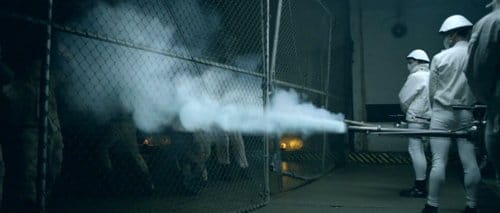
In
No Church in the Wild, police were surrounded by strobe lights and in
Never Close our Eyes, they walk around with smoke makers like those
found in clubs. Wow, riot police always really bring fun everywhere they
go!
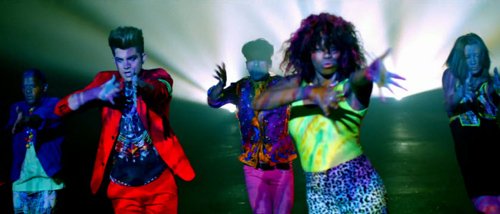
After
being smoked out by the police, Adam and his friends are shown dressed
in colorful attire and performing super funky choreography. Take that
Big Brother!
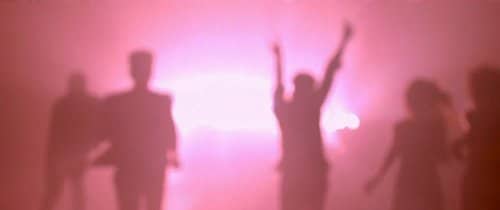
Hey gang, freedom is the other way! Why are you running back there? Why are you so happy? Why … awww screw it I give up.
We can parallel the conclusion of this video to what happens in America and the world. While the masses are increasingly getting our rights revoked, our privacy eradicated and our freedoms taken away, we do nothing about it. We are distracted with smoke and mirrors, television and cinema, escapism and denial. We celebrate a contrived and fabricated illusion of freedom, then run right back to the comfort of the elite-controlled society, allowing the elite to pursue their agenda uncontested. As Frank Zappa said: “The illusion of freedom will continue as long as it’s profitable to continue the illusion. At the point where the illusion becomes too expensive to maintain, they will just take down the scenery, they will pull back the curtains, they will move the tables and chairs out of the way and you will see the brick wall at the back of the theater.”
In Conclusion
Jay-Z and Kanye West’s No Church in the Wild and Adam Lambert’s Never Close Our Eyes are two examples of a widespread and continual effort to promote police state imagery on TVs, movie screens and computer monitors across the world. Associating cool artists who are adored by millions of people with riot police not only normalizes the concept of a police state but also creates an unconscious positive association in the minds of the viewers. Meanwhile, in real life, protests across the Western world are increasingly being met with riot police. Violent repression, brutal arrests and sophisticated weaponry are being used with less and less restraint and are even becoming the norm. Peaceful protests are often purposely sabotaged by paid agent provocateurs who incite violence, “legitimizing” the police repression.Do not be fooled by the smoke and mirrors that make up the news and music videos: The presence of heavily armed police forces during public demonstrations is not normal; rather, it is an aberration in a free and democratic society. However, this obvious fact seems to have been forgotten as police state laws and tactics and weaponry are being deployed with increasingly frequency across the world. But there is nothing cool or normal about riot police … even if they are shown with strobe lights in a Jay-Z video. Even if they dance around with Rihanna, Beyonce or Lady Gaga. Even if they’re in all the video games. An oppressive police force is the opposite of normal in a free and just society. And if riot police ever do become normal, the elite will have accomplished an incredible feat: Duping the masses into accepting a police state, without it even knowing it.
Katy Perry’s ‘Part of Me’: Using Music Videos to Recruit New Soldiers
In her music video ‘Part of Me’, Katy Perry ditches her wigs and latex dresses to put on a Marines uniform. While some might find this style change “refreshing”, the video for ‘Part of Me’ has a very specific agenda: To entice young people to enlist in the military. We’ll look at how ‘Part of Me’ is a three-minute long advertisement to recruit new soldiers for the U.S. military.

Katy Perry is usually known for wearing blue wigs and sexy dresses, but she gives it all up in Part of Me. Yup, watch out terrorists, Katy Perry is an army girl now. While “pop culture observers” welcomed Katy Perry’s image change, qualifying it as “refreshing”, most missed an important fact: In Part of Me, Katy Perry is used to push yet another agenda of the elite – the recruitment of young people into the military. If we look at it objectively, Part of Me is, in fact, a three-and-half-minute long “Join the Military” advertisement disguised as a music video. It contains all of the components found in regular TV ads for the Marines and any other army-related ads: cool high-tech war machines, excitement and action, being “All You Can Be” and so forth. But most importantly, it presents the military and, by extension, war, as the perfect escape from the bummers of regular life.
The video was shot at an actual U.S. Marine base, using actual Marines, which means that the video is truly a “sponsored message” from the Marines. By appealing to young people using singers they look up to and themes they can relate to, the U.S. military is looking to address an important issue: Getting more young people to enlist. There is indeed a growing need for fresh blood in the military as the U.S. government and other Western countries are putting intense pressure on so-called “Axis of Evil” regional powers such as Iran and Syria. The numerous military expeditions of the past few years (Iraq, Afghanistan, Libya), and increasing calls to bring home enlisted soldiers who have done multiple tours of duty means that as the U.S. prepares for upcoming conflicts, new soldiers are needed to enlist and be shipped abroad. Instead of paying for a 30-second TV commercial, military marketing specialists probably realized that they could get better results by investing in the music video of a star that is popular with teenagers. While regular “Be All You can Be” TV commercials were effective in the past, today’s young generation watches less TV and more YouTube. So why not use pop stars who getting hundreds of millions of YouTube views and who are already used to push other aspects of the elite’s agenda?
Not a New Concept
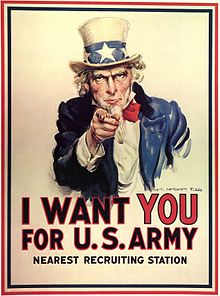
A 1917 Uncle Sam poster used to recruit soldiers during WWI
During the 1950s, although mandatory drafts were in full force, the military still looked for opportunities for good PR. When Elvis Presley, the hottest and most controversial artist of the time, joined the army as a regular soldier, the press was given “full access”, and were even allowed take pictures of him in his drawers while getting weighed in.

Elvis' career as a soldier was highly publicized, as countless pictures of him flooded mass media.
Since the 1950s, marketing techniques have improved in both efficiency and sophistication. In fact, today, the best advertisement often parades itself as no advertisement – in the advertising industry, messages are known to be received more effectively when indirectly reaching an audience that believes it is being entertained. To achieve this, celebrities and pop stars are often used as vehicles to reach the minds of young people with specific messages without them even realizing it. Katy Perry’s Part of Me is an example of this technique, as nowhere in the video does it state that it is an advertisement for the U.S. military. Perry’s video was simply used by the military to reach its target audience–teenagers approaching the age of enlistmen–but the whole thing appears as if it was a “creative” decision of Katy Perry the Artist.
Watching Part of Me immediately reminded me of the Simpsons episode were Bart and his friends were chosen by a producer to form a boy band. The group’s hit single was Yvan Eht Nioj, which was “Join the Navy” in reverse. It was later discovered that Bart Simpson’s group was used by the Navy to push subliminal messages to young people in order to get them to become soldiers.

Party Posse's music video featured the group doing cool army things in Iraq such as driving dunebuggeys and flying jet fighters.
Part of Me
The video begins with a concept most teenagers can relate to: Heartbreak. Katy catches her boyfriend kissing another woman. so she barges in and breaks up with him.
Katy
walks away from her douchebag boyfriend. Although the video is
basically a commercial for the United States military, it begins with a
relationship-related scene in order to make the video relatable and to
give it an emotional element.

When Katy reads this actual US Marines sticker, she is immediately sold.
Nevertheless, Katy makes this decision, cutting her hair in a boyish fashion and trading her Blackberry for a Marines uniform.

Katy is now the property of the U.S. military complex.

Katy
burns a letter from her boyfriend (representing her old life) while
hanging out with her Marines buddy. He's REALLY there for her.
Camaraderie between soldiers is an important selling point to help
recruit personnel and is heavily promoted in this video.
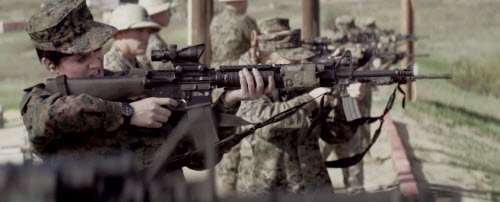
Katy
is now in a military base, shooting a rifle and will most likely be
shipped to a warzone in the near future. Take THAT cheating boyfriend,
that'll show you!

Katy,
you say you're "sparkling" but you're being trained to fight guerrilla
warfare in the Middle East, which is known to be extremely bloody,
violent and often involve civilian casualties. So, yeah, I'm not sure
that "sparkling" is the best word to describe your situation.

Katy
is now caught up in the business of war, where death, mutilation,
horror and trauma can get in the way of conquering Third World countries
for resources and power. But hey, at least Katy's douchebag boyfriend
isn't there!
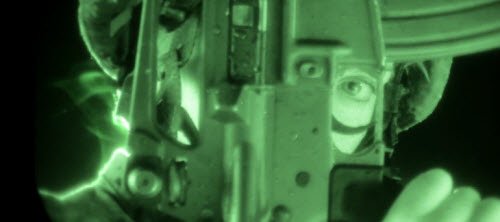
A
single eye above the trigger of a gun indicates that this
military-themed video is a product of the elite's agenda ... who happen
to have a bunch of wars planned in the coming years.
In Conclusion
Watching a bit of “international news” is enough to make one realize that there is currently a lot of pressure on “bad” countries such as Syria, Iran and Uganda, and that public opinion is being prepped for new military conflicts. The prospect of future wars, along with the countless existing warzones around the world, are generating a great need for new soldiers military in the U.S. and other Western countries. Since military drafts are no longer an option, new and innovative ways are being used to reach the army’s target audience (teenagers) and to get them interested in enlisting in armed forces. Katy Perry’s Part of Me is an obvious Marines recruitment advertisement disguised as a music video, with the Marine’s “cool” weaponry, intensive training and soldier camaraderie all presented in a dynamic and appealing matter. The military and war are presented as ideal escapes from life’s bummers, like a cheating boyfriend, and geared to appeal to a generation of bored teenagers. But is war really the perfect way to forget about a bad relationship? Go ask a war veteran.The Transhumanist and Police State Agenda in Pop Music
Today’s pop music is filled with
symbols and messages aimed to shape and mold today’s youth. Apart from
the occult symbolism discussed in other articles, other parts of the
elite’s agenda are communicated through music videos. Two of those parts
are transhumanism and the introduction of a police state. We’ll look at
the way those agendas are part of the acts of Rihanna, Beyonce, Daddy
Yankee and the Black Eyed Peas.
As seen in previous articles on this site,
the world’s biggest stars exploit common themes in their work,
permeating popular culture with a set of symbols and values. The
cohesiveness of the message that is communicated to the masses,
regardless of the artists’ musical genre, attests to the influence of a
“higher power” over the industry. Other articles on this site have
explored the way Illuminati symbolism, based on secret society
occultism, has been reflected in popular videos. Exposing and
desensitizing the world to the elite’s sacred symbols is, however, only
one aspect of their agenda. Other aspects of Illuminati control are
reflected in today’s popular music as well, including: mass mind
control, transhumanism (the “robotization” of the human body) and the
gradual introduction of a virtual police state. Through the news, movies
and the music industry, this agenda is being insidiously presented to
the masses, using various techniques. If the news scares people into
accepting measures diminishing their personal freedoms and ushering in a
“new era”, the music business accomplishes the same job by making it
seem sexy, cool and trendy. This angle is mainly aimed at the younger
crowd, which is much more susceptible to “take in” the industry’s
message.
Essential Information
If you’ve never heard of transhumanism or martial law, I suggest you visit the “Educate Yourself” section first, as I will only provide a very summary explanation of each concept here.Transhumanism
“Transhumanism is an international intellectual and cultural movement supporting the use of science and technology to improve human mental and physical characteristics and capacities. The movement regards aspects of the human condition, such as disability, suffering, disease, aging, and involuntary death as unnecessary and undesirable. Transhumanists look to biotechnologies and other emerging technologies for these purposes. Dangers, as well as benefits, are also of concern to the transhumanist movement.What is almost never mentioned is the fact that those technological “improvements” will be out of reach for the average man. The huge price tags of those scientific discoveries will render them only accessible to a select elite. While the common man is forced to seek nourishment in genetically modified, chemically altered and even poisonous foods, the elite is trying to achieve immortality through science. Even if the masses cannot have access to those discoveries, mass media makes transhumanism cool, desirable and, ultimately, acceptable.
The term “transhumanism” is symbolized by H+ or h+ and is often used as a synonym for “human enhancement”. Although the first known use of the term dates from 1957, the contemporary meaning is a product of the 1980s when futurists in the United States began to organize what has since grown into the transhumanist movement. Transhumanist thinkers predict that human beings may eventually be able to transform themselves into beings with such greatly expanded abilities as to merit the label “posthuman”. Transhumanism is therefore sometimes referred to as “posthumanism” or a form of transformational activism influenced by posthumanist ideals.
The transhumanist vision of a transformed future humanity has attracted many supporters and detractors from a wide range of perspectives. Transhumanism has been described by one critic, Francis Fukuyama, as the world’s most dangerous idea,while one proponent, Ronald Bailey, counters that it is the “movement that epitomizes the most daring, courageous, imaginative, and idealistic aspirations of humanity”.
Police State
George W. Bush’s Patriot Act has enabled the American government to expand surveillance of its citizens, whether it be phone calls, e-mails and physical movements. It also gave the government almost unlimited powers of arrest, detention, search and seizure. Donald E. Wilkes, Professor of Law at the University of Georgia School of Law describes this last concept:“I want to examine here a single section of the USA Patriot Act–section 213, definitely one of the most sinister provisions of this monstrous statute.Subsequent acts have further diminished civil liberties of citizens by enabling the government to declare any American a “terrorist” with little to no proof. The government can also declare martial law with little or no valid reason.
In euphemistic language that conceals the provision’s momentous significance, section 213 states that with regard to federal search warrants “any notice required … to be given may be delayed if … [1]the court finds reasonable cause to believe that providing immediate notification of the execution of the warrant may have an adverse result …; [2] the warrant prohibits the seizure of any tangible property … except where the court finds reasonable necessity for the seizure; and [3] the warrant provides for the giving of such notice within a reasonable period of its execution, which period may thereafter be extended by the court for good cause shown.”
Section 213 may be couched in Orwellian terminology, but there is no doubt about what it does.
Section 213 is the first statute ever enacted in the history of American criminal procedure to specifically authorize an entirely new form of search warrant-what legal scholars call the sneak and peek warrant (also dubbed the covert entry warrant or the surreptitious entry warrant). A sneak and peek search warrant authorizes police to effect physical entry into private premises without the owner’s or the occupant’s permission or knowledge to conduct a search; generally, such entry requires a breaking and entering.”
- Donald E. Wilkes, Flagpole Magazine Sept 2002.
“The John W. Warner Defense Authorization Act of 2006, “named for the longtime Armed Services Committee chairman from Virginia,” was signed October 17, 2006, by President George W. Bush. The Act “has a provocative provision called ‘Use of the Armed Forces in Major Public Emergencies’,” the thrust of which “seems to be about giving the federal government a far stronger hand in coordinating responses to [Hurricane] Katrina-like disasters,” Jeff Stein, CQ National Security Editor wrote December 1, 2006.
“But on closer inspection, its language also alters the two-centuries-old Insurrection Act, which Congress passed in 1807 to limit the president’s power to deploy troops within the United States … ‘to suppress, in a State, any insurrection, domestic violence, unlawful combination, or conspiracy’,” Stein wrote.
“But the amended law takes the cuffs off” and “critics say it’s a formula for executive branch mischief,” Stein wrote, as “the new language adds ‘natural disaster, epidemic, or other serious public health emergency, terrorist attack or incident’ to the list of conditions permitting the President to take over local authority — particularly ‘if domestic violence has occurred to such an extent that the constituted authorities of the State or possession are incapable of maintaining public order.’”
“One of the few to complain, Sen. Patrick J. Leahy, D-Vt., warned that the measure virtually invites the White House to declare federal martial law. … It ‘subverts solid, longstanding posse comitatus statutes that limit the military’s involvement in law enforcement, thereby making it easier for the President to declare martial law,’ he said in remarks submitted to the Congressional Record on Sept. 29.”
- Source
We’ll see how those concepts are cleverly
inserted into pop music in order to create specific climate in the
collective consciousness.
Rihanna’s Hard and AMA Performance
Previous articles on this site looked at the occult or mind-control related symbolism found in Umbrella, Disturbia and Russian Roulette. Fully embodying Illuminati agenda, Rihanna’s Hard incorporates the military/police state element.
In hip-hop slang, the term “hard” usually
refers to someone who is street-savvy, gritty, rebellious and who is
decisively “not down with police”. Hard transposes this term to
a military context. Her militaristic video features a gang of uniformed
men dancing under the orders of “General Rihanna”. We’ve come a long
way from Public Enemy’s Fight the Power…it is now Submit to the Power.
All of this military/dictatorial imagery is mixed with Rihanna’s sexy
moves and outfits, appealing to the masses’ basest instinct: sex. This
generates in the viewer an unconscious positive response to this
otherwise terrible backdrop. I mean, who likes to be in a war zone? Not
people who have experienced it, that’s for damn sure.
How come guns were always censored from
music videos (especially rap) until very recently? Is it only acceptable
when they are used to promote war and a police state?
Her performance in the 2009 American Music Awards
also contains a great deal of noteworthy elements. The intro video is a
disturbing display of dehumanization and Mind Control lead by a
“shadow government”. Rihanna is a cyborg being programmed by the
insertion of a microchip inside of her (RFID anyone?). Notice the
shadowy appearance of those performing the surgery.
During her performance she is surrounded by dancers wearing riot gear helmets and totting shotguns around.
At the end of the song Hard, Rihanna chants “Where the bloggers at? Where the bloggers at?”
I’m right here.
Beyonce’s Grammy Performance
Beyonce walks on stage with a bunch of men
dressed in riot gear… the type of unit a police state would use to
repress opposition during popular turmoil. What are they doing in
Beyonce’s performance? Contributing to permeate popular culture with
police-state imagery.
Is the American public being mentally prepared for martial law? But that’s impossible, Beyonce is such a good girl … oh wait.
Daddy Yankee’s Performance at Premio Lo Nuestro 2010
Reggaeton superstar Daddy Yankee has likely been chosen to promote the Agenda to the Latino community. His performance at the Premio Lo Nuestro
awards in Miami is simply a perfect Illuminati fit. At the beginning
the performance, a picture of Daddy Yankee standing under a Masonic
compass is displayed.
Daddy Yankee’s is surrounded by dancers looking like robotic cyber-police/soldiers. The name of his new single is Descontrol, which means “lose control”. Interesting.
By the way, here is the logo of Premios Lo Nuestro awards.
The Black Eyed Peas’ Imma Be Rocking that Body
This long video is all about the merger of humans and robots, which is, as seen above, the ultimate goal of transhumanism. It starts with Fergie saying “we are not robots!” … only to see her become a half-robot shooting a gun that causes an irresistible need to breakdance.Will.I.Am starts his verse by saying “Imma be the upgraded new negro”, which pretty much sums up the transhumanist philosophy.
At the end of the video, Fergie wakes up from her “dream”. It sure was cool when she was a robot, wasn’t it?
In Conclusion
Articles on this site have mainly focused on the occult symbols found in music videos. There are, however, other aspects of the Illuminati agenda that are present in popular culture. Transhumanism and the establishment of a virtual police state are two objectives that are slowly but surely being implemented with little to no public debate. Movies, video games and the music industry are doing the job of leading the masses’ collective consciousness towards a new era by saturating the airwaves with those concepts. The “robot agenda”, as some observers call it, has been an intricate part of the music industry for years now and examples of it are way too many to enumerate. The theme of the “upgraded human” due to his robotization has been exploited by most of today’s international stars. There is a difference between a trend and an agenda.The “police state” element found in video and performances is relatively new but equally, if not more, disturbing. Music has always been a healing, liberating and emancipating medium. Looking at the music industry’s products of the last years, is there a possibility of it being hijacked by an ever-intrusive elite? Think about who owns the record companies.
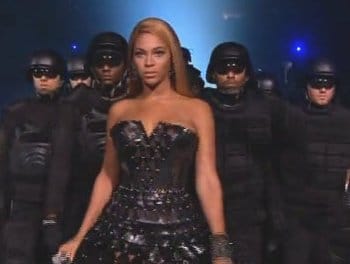


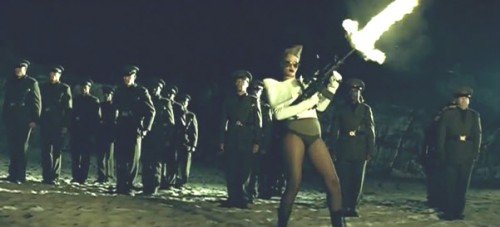

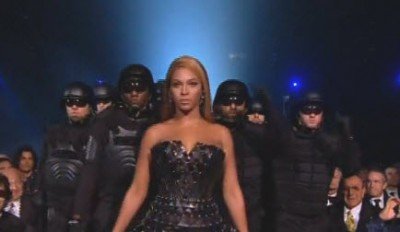

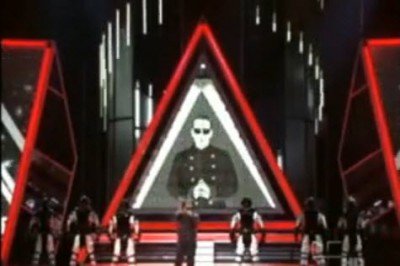

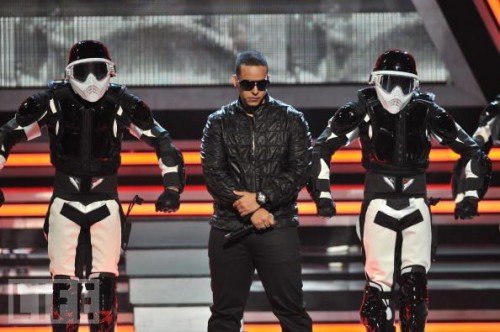
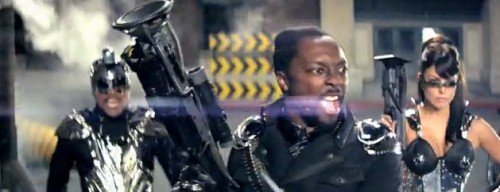
حلويات شرقية
ReplyDeleteحلويات شرقية
حلويات شرقية
حلويات شرقية
حلويات شرقية
Delivery Services in Dubai
ReplyDeleteDelivery Services
Always look forward for such nice post & finally I got you. Really very impressive post & glad to read this.
ReplyDeleteWeb Development Company in Greater Noida
Software development company In Greater noida
Always look forward for such nice post & finally I got you. Thanks for sharing this content.
CMS and ED
CMSED
Homoeopathic treatment for Psoriasis in greater noida
Kidney Disease Homoeopathy Doctor In Greater Noida
Good luck & keep writing such awesome content.
ReplyDeleteBest dental clinic in Faridabad
Car Hire In Greater Noida